Nathdwara
 Nathdwara means the gate of God. It is the most renowned pilgrim of India. Nathdwara is located on the banks of Benas river just 48 kms ahead of Udaipur. Nathdwara is also famous for the Pichhwai paintings – the most famous Rajasthani art. This art portrays the Lord Shrinathji & their activities
Nathdwara means the gate of God. It is the most renowned pilgrim of India. Nathdwara is located on the banks of Benas river just 48 kms ahead of Udaipur. Nathdwara is also famous for the Pichhwai paintings – the most famous Rajasthani art. This art portrays the Lord Shrinathji & their activities
The town is typical of this region of north India. The stone or brick houses have thick, whitewashed walls that keep the interior cool in the summer heat. During the winter months the warmest place is a sunny roof, and a favourite winter pastime for children is flying kites from the rooftops.Although Nathadwara may look like other Rajasthani towns.
HOW TO REACH
By Air - Udaipur, the nearest airport is south at a distance of 48km.
By Train - Udaipur again is the nearest railhead, from where you’ll have to take a bus or a taxi ride to Nathdwara. However, Nathdwara does have a small railway station, which is about 13km away from the town. It also has a railway reservation office about five minute walk away from the Nathji temple.
By Road - Express buses of the state tourism as well as private companies ply between Nathdwara and major towns like Ahmedabad, Pushkar, Ajmer, Jaipur and Delhi. From Udaipur also.
WHEN TO GO
The best time to visit Nathdwara is just after the monsoon to the winters. Periodically from September to March is the ideal time to get most of it.
WHAT TO SEE
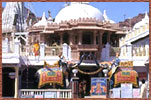 Shri Nathji Temple - This temple is the only major attraction Nathdwara. This 17th century temple house the original statue of Shrinathji or Lord Krishna. According to history, the statue was brought to Mewar kingdom for the sake of safety in the period of Aurangazeb the Moghul monarch. The chariot shipping the statue was jammed here, and consequently a shrine was established with the permission of the then Rana of Mewar at Nathdwara.
Shri Nathji Temple - This temple is the only major attraction Nathdwara. This 17th century temple house the original statue of Shrinathji or Lord Krishna. According to history, the statue was brought to Mewar kingdom for the sake of safety in the period of Aurangazeb the Moghul monarch. The chariot shipping the statue was jammed here, and consequently a shrine was established with the permission of the then Rana of Mewar at Nathdwara.
Darshans or glimpses of Srinathji can be sought 8 times in the day. individually known as Ashtaya, the 8 darshans are Mangala, Shrungar, Gwal, Rajbhog, Uthhapan, Bhog, Sandhaya Aarti and Shayan. In each of them the leelas (divine manifestations) of the Lord are described and harmonized with His daily routine. Millions of devotees come here every year, to make there wish and pray to the almighty Lord Krishna.
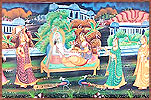 Pichhwai Paintings - Nathdwara is also famous for its Pichhwai paintings, which are very similar in theme to the thangka paintings of Ladakh and Tibet. Local Brahmin artists produce fine and intricate paintings on paper and cloth. Literally meaning ‘something at the back’, these are large paintings on cloth portraying Shri Nathji in various costumes and moods. The Lord is also shown in the forests surrounded by cows and gopinis (milkmaids). They depict the events and happenings in the god’s life and are frequently changed to create different moods depending on the occasion and ritual. Ink blue clouds and dancing peacocks represent Lord Krishna with his blue complexion while the cows symbolize the devotees craving for their Lord. The name pichhwai has been derived from the position of the painting behind the image of the deity in Vaishnava temples of the Pushti Marga sect devoted to the childgod Krishna.
Pichhwai Paintings - Nathdwara is also famous for its Pichhwai paintings, which are very similar in theme to the thangka paintings of Ladakh and Tibet. Local Brahmin artists produce fine and intricate paintings on paper and cloth. Literally meaning ‘something at the back’, these are large paintings on cloth portraying Shri Nathji in various costumes and moods. The Lord is also shown in the forests surrounded by cows and gopinis (milkmaids). They depict the events and happenings in the god’s life and are frequently changed to create different moods depending on the occasion and ritual. Ink blue clouds and dancing peacocks represent Lord Krishna with his blue complexion while the cows symbolize the devotees craving for their Lord. The name pichhwai has been derived from the position of the painting behind the image of the deity in Vaishnava temples of the Pushti Marga sect devoted to the childgod Krishna.
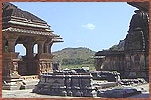 Other Temple Attractions -Nathdwara has several other temples dedicated to Madana Mohana and Naveet Priya, all located in the main Shri Nathji temple complex. The former deity was gifted to the temple by the wife of Maharana Fateh Singh of Udaipur. Naveet Priya temple is dedicated to Lord Krishna, or one who is fond of butter (naveet means butter and priya means lover). The Banamali Temple is also a Krishna Temple and is located to the right of the Shri Nathji Temple, while the Vitthalnath Temple is right opposite the entrance of the Shri Nathji Temple. The deity of this temple was previously located at Gokula in Brajbhumi or the land of the Braj. According to Indian mythology, Lord Krishna had spent his childhood days here at Gokula.
Other Temple Attractions -Nathdwara has several other temples dedicated to Madana Mohana and Naveet Priya, all located in the main Shri Nathji temple complex. The former deity was gifted to the temple by the wife of Maharana Fateh Singh of Udaipur. Naveet Priya temple is dedicated to Lord Krishna, or one who is fond of butter (naveet means butter and priya means lover). The Banamali Temple is also a Krishna Temple and is located to the right of the Shri Nathji Temple, while the Vitthalnath Temple is right opposite the entrance of the Shri Nathji Temple. The deity of this temple was previously located at Gokula in Brajbhumi or the land of the Braj. According to Indian mythology, Lord Krishna had spent his childhood days here at Gokula.
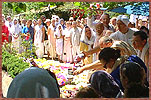 Annakuta Festival -The largest is known as Annakuta, which is simply a continuation of the traditional worship of the Govardhana Hill as performed by the people of Vrindavan. It takes place a day before the Diwali, another Indian festival that is celebrated with much fervour and vigour. A hill is made of 2,500kg of rice and is offered to the deity of Shri Nathji. and then the temple gates are closed which are opened only in the evening during the darshan of the Lord. The looting of the prasada (mainly sweet offerings to a deity) of rice from the annakuta (the rice hill) follows. Every single worshipper of the Lord joins in the looting with much enthusiasm.
Annakuta Festival -The largest is known as Annakuta, which is simply a continuation of the traditional worship of the Govardhana Hill as performed by the people of Vrindavan. It takes place a day before the Diwali, another Indian festival that is celebrated with much fervour and vigour. A hill is made of 2,500kg of rice and is offered to the deity of Shri Nathji. and then the temple gates are closed which are opened only in the evening during the darshan of the Lord. The looting of the prasada (mainly sweet offerings to a deity) of rice from the annakuta (the rice hill) follows. Every single worshipper of the Lord joins in the looting with much enthusiasm.
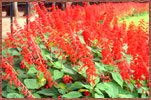 Lal Bagh - The Lag bagh is a beautiful garden outside the city. There you can find lot of rare plants & trees.
Lal Bagh - The Lag bagh is a beautiful garden outside the city. There you can find lot of rare plants & trees.
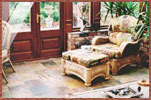 Handmade Terracottas - Nathdwara is also a major centre for handmade terracottas. A small place near Nathdwara called Molela produces this extraordinary folk art. The tradition of terracotta in this area goes a long way back by about 2,000 years. Today only about 20 families practice this dying art.
Handmade Terracottas - Nathdwara is also a major centre for handmade terracottas. A small place near Nathdwara called Molela produces this extraordinary folk art. The tradition of terracotta in this area goes a long way back by about 2,000 years. Today only about 20 families practice this dying art.
WHERE TO EAT
There are so many good restaurants in Nathdwara, suitable for all pockets.








